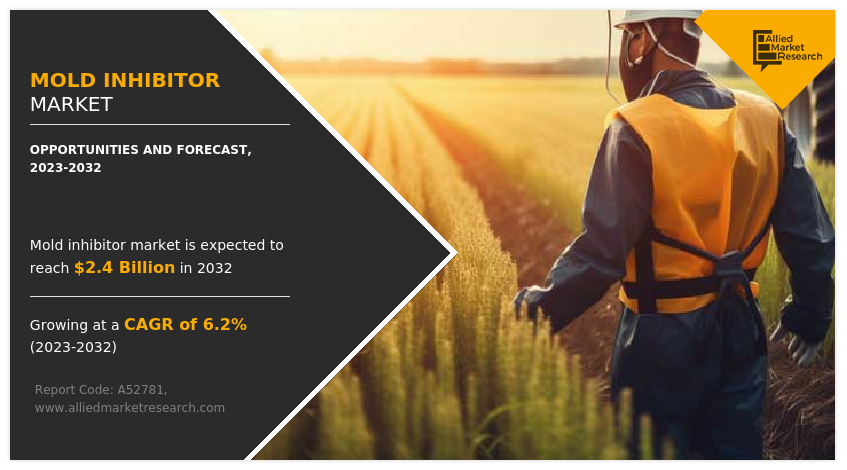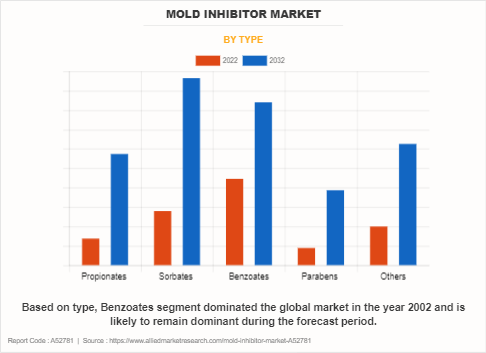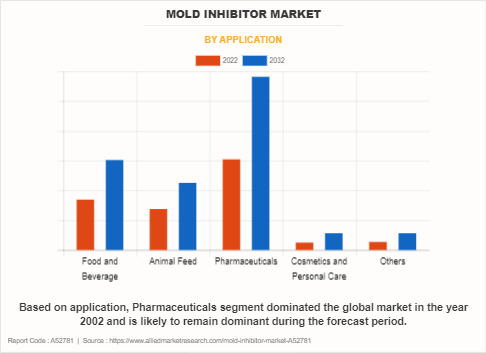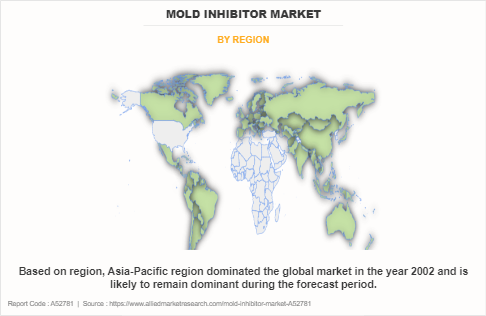Mold Inhibitor Market Research, 2032
The global Mold Inhibitor Market Size was valued at $1.3 billion in 2022, and is projected to reach $2.4 billion by 2032, growing at a CAGR of 6.2% from 2023 to 2032. Mold inhibitors, commonly known as preservatives, are substances incorporated into various food to impede the growth and proliferation of mold, thereby extending the shelf life of the product. These inhibitors play a crucial role in preventing spoilage, maintaining freshness, and ensuring food safety. Chemical preservatives, such as propionic acid-based blends, such as those found in liquid mold inhibitors, are widely used to control microbes and hinder mold development in baked goods. Natural preservatives, such as natamycin, have also gained prominence for their effectiveness against various molds and fungi. The primary function of mold inhibitors is to create an environment hostile to mold growth, thereby protecting food items from contamination and degradation. As consumers demand cleaner labels, there is a growing emphasis on the development of clean label mold inhibitors that offer preservation without compromising on the overall quality and health aspects of food products.

Market Dynamics
Growth in the food industry and the rising awareness of food safety
A key global trend in the mold inhibitor market is the increasing demand driven by the growth in the food industry and the rising awareness of food safety. As consumers become more conscious about the quality and longevity of food products, the mold inhibitor market is experiencing substantial expansion. The heightened focus on preventing mold growth in food items, particularly in baked goods and convenience products, has led to a surge in the adoption of mold inhibitors. Additionally, the trend toward clean labels and natural preservatives is influencing the market, with a preference for inhibitors that align with clean and transparent product labeling.
The market is witnessing technological advancements in mold inhibitor formulations, enhancing their efficacy and broadening their application spectrum. This trend is in response to the evolving regulatory landscape and consumer preferences, pushing manufacturers to innovate and develop more efficient and sustainable mold inhibitor solutions. With the global food industry continuously evolving, the mold inhibitor market is projected to witness growth, addressing the crucial need for extending the shelf life of perishable goods while meeting the demand for safe and high-quality food products.
Growth of meat consumption
Meat production and consumption has increased rapidly over the years due to increased disposable income of the consumers and the health benefits offered by meat. In addition, meat is a rich source of proteins, important vitamins, and various other nutrients such as iron, zinc, B12, and B6. It has been observed that meat consumption in the developing economies is higher than in the developed regions. The economic growth, changes in lifestyle, population growth, and other structural changes are driving the livestock revolution, and hence supplementing the overall growth of the mold inhibitor market.
Some of the products are high in cholesterol and saturated fat and, therefore, standardization is a necessity. The starch content, fat-free content, and other tests are undertaken by the International Organization of Standardization to protect animals from any uncertain diseases. However, more than 70% of antibiotics are used in livestock, and these antibiotics are illegally added to animals’ diets for the purpose such as weight gain or treating illness.
Raw materials in the mold inhibitor market include cereal grains, fats & oils, added vitamins, minerals, and other nutritional sources. The volatile price of these raw materials is expected to hamper the growth of the global mold inhibitor market. Moreover, increased prices of protein meals are also anticipated to restrain the market growth, as it allows producers to add low-cost ingredients in feed additives, which later harm the health of animals. This in turn hampers the growth of the market.
Government intervention for usage of feed additives
Government intervention for usage of feed additives in every country is expected to restrain market growth. Antibiotics used in animal feed are banned in some countries. As a result of which, the feed enterprises carry out formula adjustments and make changes in feed processing, which is a time-consuming process. Thus, implementation of stringent regulations hampers market growth.
The use of antibiotics in animal feed has witnessed a significant growth in recent decades. Antimicrobials are widely used in livestock by veterinarians and livestock owners for prevention of diseases. Some of the countries outside Europe use antimicrobials to increase the growth rate of livestock, poultry, and other farmed animals. In addition, China is one of the biggest producers and consumers of antibiotics. Thus, a rise in utilization of antibiotics in livestock is expected to provide potential opportunities for Mold Inhibitor Market Growth.
Segmental Overview
The mold inhibitor market is segmented on the basis of type, application, and region. By nature, the market is classified as natural and synthetic. By type, the market is categorized into propionates, sorbates, benzoates, parabens and Others. By application, the market is classified into food & beverage, animal feed, pharmaceuticals, cosmetics and personal care and others. Region wise, the market is analyzed across North America, Europe, Asia-Pacific, Latin America and Middle East & Africa.
By Type
By Type, the Benzoates segment dominated the global market in the year 2022 and is likely to remain dominant during the forecast period. This dominance is expected to persist throughout the forecast period, driven by several factors. Firstly, the versatile applications of benzoates, ranging from food and beverages to pharmaceuticals, position them as indispensable mold inhibitors in diverse sectors. Additionally, ongoing research and advancements in benzoate formulations contribute to their sustained efficacy, bolstering their market presence.

By Application
By application, the pharmaceuticals segment had the dominating Mold Inhibitor Market Share in the year 2022 and is likely to remain dominant during the forecast period. This is attributed to the critical role mold inhibitors play in preserving the integrity and efficacy of pharmaceutical products. As the pharmaceutical industry continues to witness rapid growth, the Mold Inhibitor Market Demand, crucial for preventing contamination and ensuring product quality, has surged. Stringent regulatory requirements in the pharmaceutical sector further accentuate the need for effective mold inhibition strategies, making pharmaceutical companies the primary consumers of mold inhibitors. Moreover, with the global emphasis on healthcare and the increasing awareness of the importance of drug safety, the pharmaceuticals segment is poised to maintain its lead in mold inhibitor consumption. As the forecast period unfolds, the pharmaceuticals segment is likely to witness sustained dominance due to ongoing advancements in pharmaceutical manufacturing technologies, driving the continual reliance on mold inhibitors for product preservation and quality assurance.

By Region
By Region, the Asia-Pacific region dominated the Mold Inhibitor Industry in 2022 and is expected to remain dominant during the Mold Inhibitor Market Forecast period. The burgeoning demand for mold inhibitors in key industries, such as food and beverages, pharmaceuticals, and construction, has fueled the market's Mold Inhibitor Market Growth in Asia-Pacific. Additionally, robust economic growth, rapid industrialization, and a burgeoning population have stimulated the need for effective mold control measures in manufacturing and residential sectors, further propelling the market. Furthermore, proactive regulatory initiatives and stringent standards for health and safety in countries like China, India, and Japan have accelerated the adoption of mold inhibitors. The Asia-Pacific region's strategic focus on technological advancements, coupled with increasing investments in research and development, positions it as a hub for innovation in mold inhibition solutions. As a result, the region not only dominated the market in 2022 but is expected to sustain its leadership, offering lucrative opportunities for industry players. The combination of robust Mold Inhibitor Industrydemand, regulatory support, and a commitment to innovation cements Asia-Pacific's stronghold in the global mold inhibitor market.

Competition Analysis
Key players included in the mold inhibitor market analysis are Kemin Industries, Niacet Corporation, Archer Daniels Midland Company, E. I. du Pont de Nemours and Company, Tate & Lyle PLC, Koninklijke DSM N.V., Associated British Food plc, Handary S.A., Pacific Coast Chemicals, CSM Ingredients, PMC Biogenix Inc., Eastman Chemical Company, Univar Solutions Inc., Brenntag AG, and Galactic SA. These companies play a pivotal role in providing innovative mold inhibitor solutions to meet the growing demands of the food industry and ensure the safety and longevity of various food products. Their extensive expertise and commitment to quality contribute to the overall advancement and expansion of the global mold inhibitor market.
Key Benefits for Stakeholders
- This report provides a quantitative analysis of the market segments, current trends, estimations, and dynamics of the mold inhibitor market analysis from 2022 to 2032 to identify the prevailing mold inhibitor market opportunities.
- The market research is offered along with information related to key drivers, restraints, and opportunities.
- Porter's five forces analysis highlights the potency of buyers and suppliers to enable stakeholders make profit-oriented business decisions and strengthen their supplier-buyer network.
- In-depth analysis of the mold inhibitor market segmentation assists to determine the prevailing market opportunities.
- Major countries in each region are mapped according to their revenue contribution to the global market.
- Market player positioning facilitates benchmarking and provides a clear understanding of the present position of the market players.
- The report includes the analysis of the regional as well as global mold inhibitor market trends, key players, market segments, application areas, and market growth strategies.
Mold Inhibitor Market Report Highlights
| Aspects | Details |
| Forecast period | 2022 - 2032 |
| Report Pages | 249 |
| By Type |
|
| By Application |
|
| By Region |
|
| Key Market Players | Archer Daniels Midland Company, Chr. Hansen Holding A/S, Koninklijke DSM N.V., Eastman Chemical Company, Corbion Purac N.V., BASF SE, Kerry Group, DuPont, Kemin Industries, Inc., Galactic SA |
Analyst Review
The mold inhibitor market is currently experiencing noteworthy growth, driven by an increased understanding of the potential health risks associated with mold and a rising need for preventive solutions across various industries. In simple terms, mold inhibitors are substances that help stop the growth of mold, and their demand is growing because people want to keep their surroundings clean and safe.
In the construction industry, which involves building houses and structures, there is a growing awareness about the harm that mold can cause. Mold can damage buildings and, more importantly, affect the air inside, making it unhealthy to breathe. As a result, builders and people who own homes are looking for ways to prevent mold, creating a demand for effective mold inhibitors.
The food and beverage industry is also a key player in this market. Businesses that make food and drinks are using mold inhibitors to make their products last longer. This not only helps in preserving the quality of the products but also ensures that consumers are not unknowingly exposed to harmful mold. Imagine buying food from the store, and it stays fresh for a longer time – that's the role of mold inhibitors in this industry.
Hospitals and other healthcare facilities are another important part of the mold inhibitor market. These places need to be very clean and sterile to keep patients safe. Mold can be especially harmful in healthcare settings, so using mold inhibitors becomes crucial in preventing its growth and maintaining a healthy environment for patients.
The global mold inhibitor market was valued at $1,324.7 million in 2022, and is projected to reach $2,444.4 million by 2032, registering a CAGR of 6.2% from 2023 to 2032.
The mold inhibitor market is product type, application, and region. 2023-2032 would be the forecast period in the market report.
The pharmaceuticals segment held the largest market share in 2022, however, the cosmetics and personal care segment is expected to grow at the fastest rate during the forecast period. $1.3 billion is the market value of the mold inhibitor market in 2022.
The mold inhibitor market is analyzed across North America, Europe, Asia-Pacific, LA and MEA. 2022 is the base year calculated in the Mold inhibitor market report.
The top companies that hold the market share are Kemin Industries, Niacet Corporation, Archer Daniels Midland Company, E. I. du Pont de Nemours and Company, Tate & Lyle PLC, Koninklijke DSM N.V., Associated British Food plc, Handary S.A.
Loading Table Of Content...
Loading Research Methodology...



